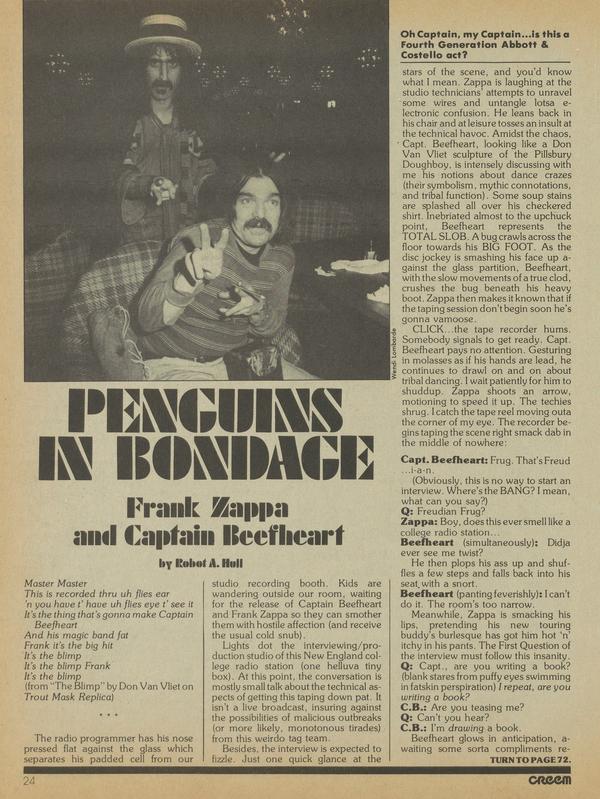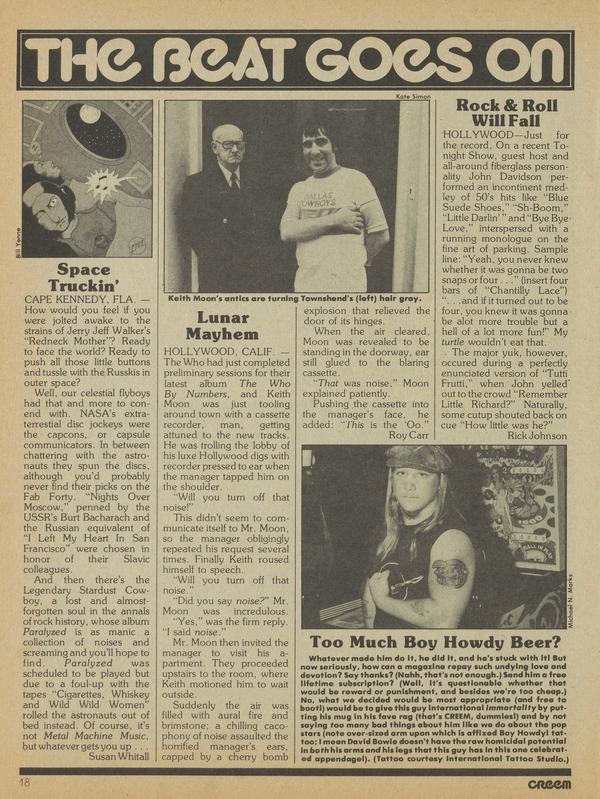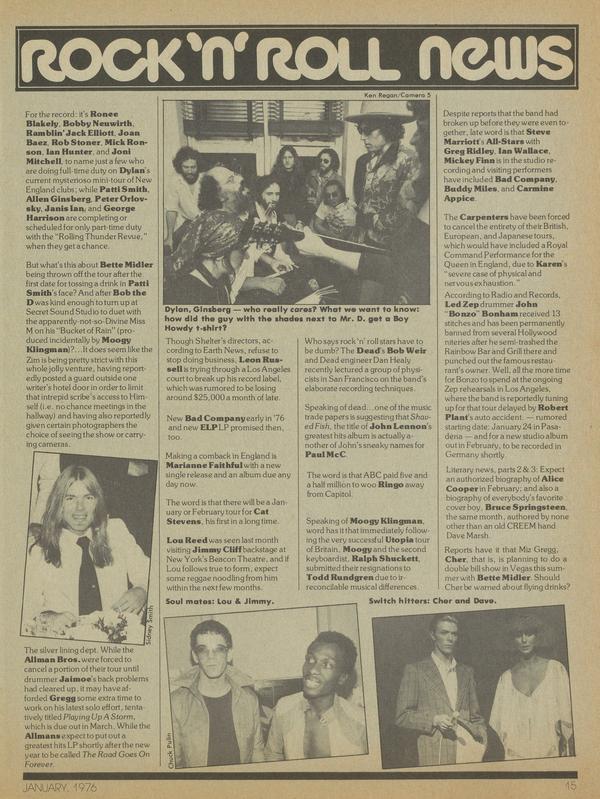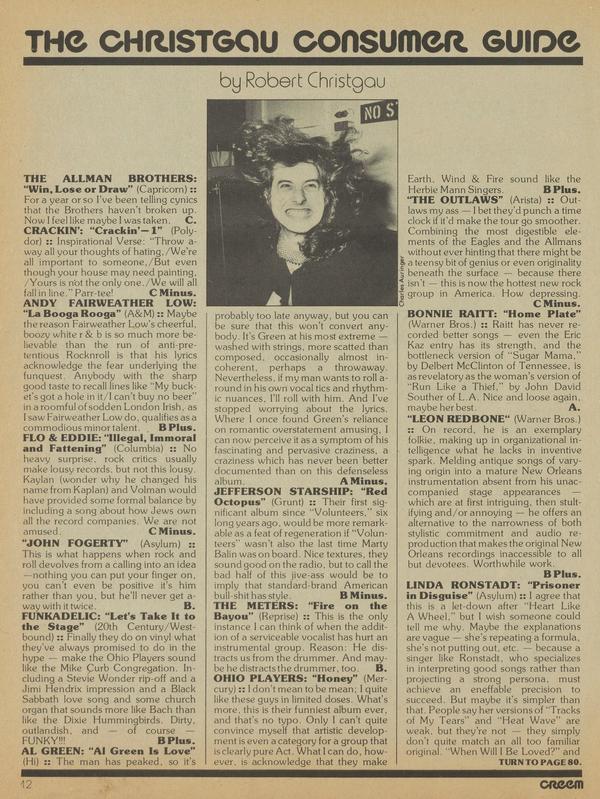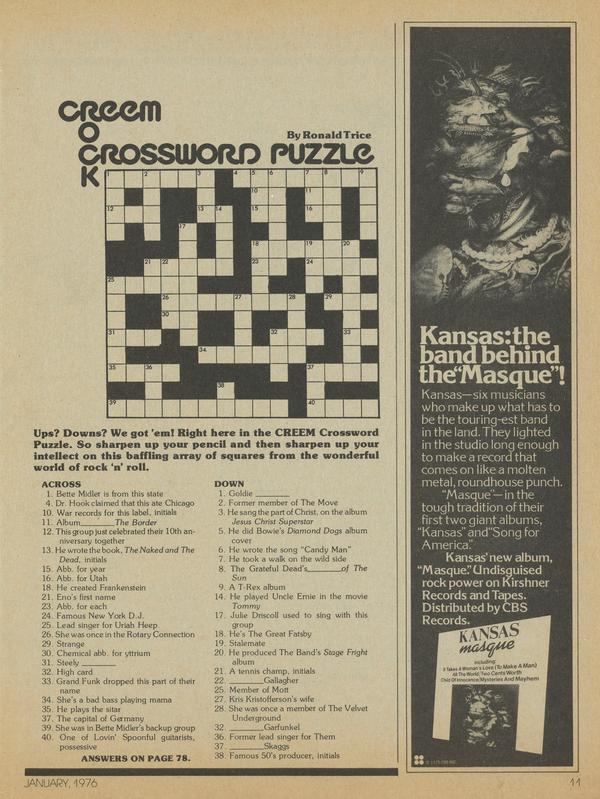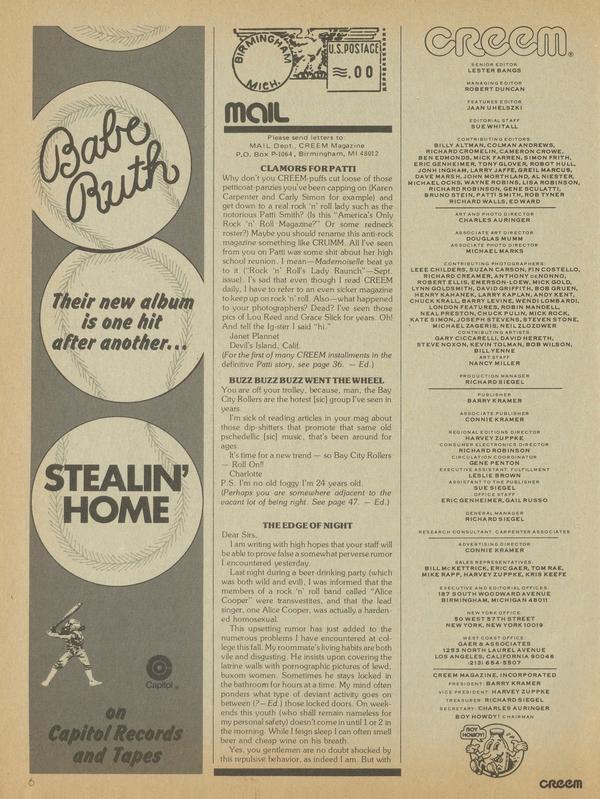Creemedia
TRUCKIN’
Truckdriving Movies Chills, thrills, spills, pills...not to mention Detroit on a Friday afternoon, that’s something else... Truckdriving folklore is so rich in potential excitement that you’d expect truckdriving movies to be as important a genre as westerns.

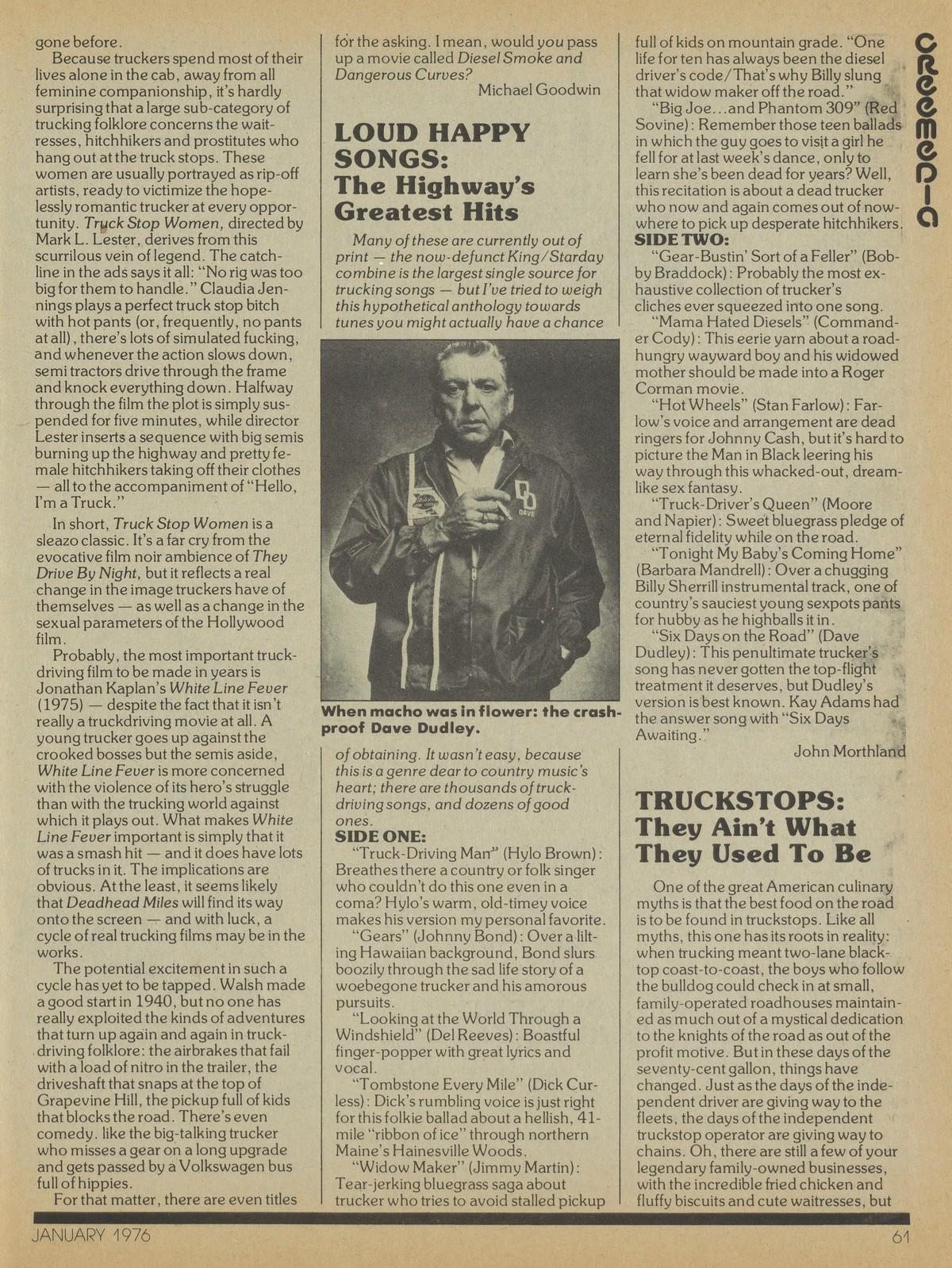
The CREEM Archive presents the magazine as originally created. Digital text has been scanned from its original print format and may contain formatting quirks and inconsistencies.
Truckdriving Movies
Chills, thrills, spills, pills...not to mention Detroit on a Friday afternoon, that’s something else...
Truckdriving folklore is so rich in potential excitement that you’d expect truckdriving movies to be as important a genre as westerns. There’s more than enough action, suspense, comedy and conflict in any good truckdriving song to support a whole series of films, let alone one good one. Yet, truckdriving movies have been relatively few and far between; as for good truckdriving movies, well, there was one.
In 1940, director Raoul Walsh shot the all-time classic trucking movie — They Drive By Night. A perfect cast, featuring George Raft, Humphrey Bogart and Ida Lupino was a big plus, but the story (about two truckdriving brothers who go up against the crooked bosses), dialogue and atmosphere were equally inspired. Who can forget those funky truckstops, or those longdistance runs through an empty American night? Walsh captured the spirit of the trucking subculture better than anyone before or since: the violent undercurrents, the transcendental boredom, the sense of constant danger just past the bend. It was a romanticized vision, but truckers had always seen themselves as romantic heroes anyway — it went with the territory.
One would have expected a series of trucking films to follow, but it was nearly 15 years before the next one worth mentioning — and that one was French. The Wages of Fear {1955) featured Yves Montand in a role that appears again and again in trucker mythology: the nitro driver. Set in South America, The Wages of Fear is still one of the most exciting suspense thrillers ever made.
The Sixties were thin. There was an obscure French film with Jean-Paul Belmondo about truckdriving in (if memory serves) Algeria, and an occasional British cheapo with trucks thrown in for background, but American filmmakers seemed to have given up on serious trucking movies.
The break come in 1972 with (of all things) an exploitation movie called Night Call Nurses — a comedyadventure that featured a young truckdriver as one of its central characters. The trucker is slid into the film’s hospital setting when he’s brought in hallucinating from too many whities. Soon he’s on the road to recovery (thanks to the special efforts of four gorgeous nurses), and the climax of the film takes place in the cab of his semi, as he drives a black revolutionary through police lines to a getaway plane.
The trucker in Night Call Nurses must have been the right character at the right time, because two more trucking films followed closely. One, Deadhead Miles, directed by underground filmmaker Vernon Zimmerman, is still unreleased. The other was a hard-R exploitation picture called Truck Stop Women (1974) — and a complete departure from everything that had gone before.
Because truckers spend most of their lives alone in the cab, away from all feminine companionship, it’s hardly surprising that a large sub-category of trucking folklore concerns the waitresses, hitchhikers and prostitutes who hang out at the truck stops. These women are usually portrayed as rip-off artists, ready to victimize the hopelessly romantic trucker at every opportunity. TryckStop Women, directed by Mark L. Lester, derives from this scurrilous vein of legend. The catchline in the ads says it all: “No rig was too big for them to handle.” Claudia Jennings plays a perfect truck stop bitch with hot pants (or, frequently, no pants at all), there’s lots of simulated fuckihg, and whenever the action slows down, semi tractors drive through the frame and knock everything down. Halfway through the film the plot is simply suspended for five minutes, while director Lester inserts a sequence with big semis burning up the highway and pretty female hitchhikers taking off their clothes — all to the accompaniment of “Hello, I’m a Truck.”
In short, Truck Stop Women is a sleazo classic. It’s a far cry from the evocative film noir ambience of They Drive By Night, but it reflects a real change in the image truckers have of themselves — as well as a change in the sexual parameters of the Hollywood film.
Probably, the most important truckdriving film to be made in years is Jonathan Kaplan’s White Line Fever (1975) — despite the fact that it isn’t really a truckdriving movie at all. A young trucker goes up against the crooked bosses but the semis aside, White Line Fever is more concerned with the violence of its hero’s struggle than with the trucking world against which it plays out. What makes White Line Fever important is simply that it was a smash hit — and it does have lots of trucks in it. The implications are obvious. At the least, it seems likely that Deadhead Miles will find its way onto the screen — and with luck, a cycle of real trucking films may be in the works.
The potential excitement in such a cycle has yet to be tapped. Walsh made a good start in 1940, but no one has really exploited the kinds of adventures that turn up again and again in truckdriving folklore: the airbrakes that fail with a load of nitro in the trailer, the driveshaft that snaps at the top of Grapevine Hill, the pickup full of kids that blocks the road. There’s even comedy, like the big-talking trucker who misses a gear on a long upgrade and gets passed by a Volkswagen bus full of hippies.
For that matter, there are even titles for the asking. I mean, would you pass up a movie called Diesel $mo/ce and Dangerous Curves?
Michael Goodwin
LOUD HAPPY SONGS:
The Highway’s Greatest Hits
Many of these are currently out of print — the now-defunctKing/Starday combine is the largest single source for trucking songs — but I’ve tried to weigh this hypothetical anthology towards tunes you might actually have a chance of obtaining. It wasn’t easy, because this is a genre dear to country music’s heart; there are thousands of truckdriving songs, and dozens of good ones.
SIDE ONE:
“Truck-Driving Marr” (Hylo Brown): Breathes there a country or folk singer who couldn’t do this one even in a coma? Hylo’s warm, old-timey voice makes his version my personal favorite.
“Gears” (Johnny Bond): Over a lilting Hawaiian background, Bond slurs boozily through the sad life story of a woebegone trucker and his amorous pursuits.
“Looking at the World Through a Windshield” (DelReeves): Boastful finger-popper with great lyrics and vocal.
“Tombstone Every Mile” (Dick Curless): Dick’s rumbling voice is just right for this folkie ballad about a hellish, 41mile “ribbon of ice” through northern Maine’s Hainesville Woods.
“Widow Maker” (Jimmy Martin): Tear-jerking bluegrass saga about trucker who tries to avoid stalled pickup
full of kids on mountain grade. “One life for ten has always been the diesel driver’s code/That’s why Billy slung / that widow maker off the road.”
“Big Joe.. .and Phantom 309” (Red Sovine): Remember those teen ballads in which the guy goes to visit a girl he fell for at last week’s dance, only to learn she’s been dead for years? Well, this recitation is about a dead trucker who now and again comes out of nowwhere to pick up desperate hitchhikers. SIDE TWO:
“Gear-Bustin’ Sort of a Feller” (Bobby Braddock): Probably the most exhaustive collection of trucker’s cliches ever squeezed into one song.
“Mama Hated Diesels” (Commander Cody): This eerie yarn about a roadhungry wayward boy and his widowed mother should be made into a Roger Corman movie.
“Hot Wheels” (Stan Farlow): Farlow’s voice and arrangement are dead ringers for Johnny Cash, but it’s hard to picture the Man in Black leering his way through this whacked-out, dreamlike sex fantasy.
“Truck-Driver’s Queen” (Moore and Napier): Sweet bluegrass pledge of eternal fidelity while on the road.
“Tonight My Baby’s Coming Home” (Barbara Mandrell): Over a chugging Billy Sherrill instrumental track, one of country’s sauciest young sexpots pants for hubby as he highballs it in.
“Six Days on the Road” (Dave Dudley): This penultimate trucker’s song has never gotten the top-flight treatment it deserves, but Dudley’s version is best known. Kay Adams had the answer song with “Six Days Awaiting.”
John Morthlartd
TRUCKSTOPS: They Ain’t What They Used To Be
One of the great American culinary myths is that the best food on the road is to be found in truckstops. Like all myths, this one has its roots in reality: when trucking meant two-lane blacktop coast-to-coast, the boys who follow the bulldog could check in at small, family-operated roadhouses maintained as much out of a mystical dedication to the knights of the road as out of the profit motive. But in these days of the seventy-cent gallon, things have changed. Just as the days of the independent driver are giving way to the fleets, the days of the independent truckstop operator are giving way to chains. Oh, there are still a few of your legendary family-owned businesses, with the incredible fried chicken and fluffy biscuits and cute waitresses, but they are dying, located next to a highway that is now bypassed by the Interstate.
Of course, there’s a lot more than coffee for sale in a good truckstop. A well-equipped truckstop should offer rooms, showers,pool-tables, pinball (where it’s legal), a bar, a well-stocked jukebox, truck-washing facilities (also good for C&W band buses), diesel fuel (for you Mercedes-drivers), a halfwaydecent parts selection, Western Union, tow service, a CB-rig (Citizen Band radio) shop, a CB station to check on road conditions and Smokeys (cops), money order and permit service, plenty of pay telephones, a gift shop featuring truck souvenirs, models, ashtrays, gewgaws for your cab interior, Western clothing and boots, gifts for the ol’.lady, 8-tracks and cassettes (including the new rage — pornographic tapes where a sexy young thing tells dirty stories), and, of course, there’s got to be a restaurant, divided into two sections: one for the “tourists” who drive the “four-wheelers” and one for the men who drive the big rigs. Those “Truckers Only!” signs mean it, and yes, they will ask you to move, and yes, if you don’t move they’ll ask you to leave. They mean it — those guys don’t want to deal with your bullshit because they’d rather deal with their own, telling tales and wondering how long it’s gonna be till the price of gas turns ’em all 1 into tourists their own selves. ’
The truckstop menu, particularly in those chains, is a sorry thing these days. Once was the time you could get eight pieces of fried chicken in a basket with a whole bunch of dinner rolls, some butter and honey, coleslaw or salad, coffee or iced tea and a piece of pie for around two bucks, and if you walked back to your rig quietly enough, you could hear how fresh the chicken was, but no more. The prices are up, the quality is the same as any HoJo, and about the only remnant of the glorious past is the world-famous dish, chicken-fried steak with cream gravy.
Petaluma Pete
OVERDRIVE: Riding The Rag
You don’t need to be told who reads The Highway Evangelist. Regional magazines like Truck Tracks (on the West Coast) flourish everywhere. Owner-Operator has a sizeable readership among gypsy (independent) truckers, but the Big Daddy of them all is indisputably Overdrive.
Published monthly out of Hollywood by a fire-breathing former trucker named Mike Parkhurst, Overdrive espouses a militant philosophy of rugged individualism and the self-made man. The magazine also puts its money where its mouth is, which is why gypsy drivers swear by it. Overdrive sponsors a Roadmasters Club that offers reasonable insurance rates, accepts collect calls from arrested drivers and gets them a lawyer, and the like. When truckers shut down in protest during the 1974 fuel shortage, Overdrive was there to help co-ordinate the boycotts and road blocks. It then came out with a special issue threatening mayhem if the truckers were not heard, and Parkhurst himself stormed into Washington to give holy hell to the energy commission, the ICC, Congress, and anyone else he thought deserved it.
Regular issues combine investigative reporting, service features and consumer reports with barely-covered tits and ass. Monthly departments include the Tractor of the Month photo spread, a “Clutch a Caption” contest in which readers can win $25 for providing a punch line to a cartoon, columns on country music and advice to the lovelorn, and a major interview with someone like economist Milton Friedman, ex-trucker Rock Hudson, or Charley Pride. New equipment is conscientiously reviewed, and there are human interest features such as “Truckers.. .Horny or Holy?,” in which drivers discuss their sex lives, or lack thereof, while on the road. Parkhurst prints a steady stream of articles railing against ICC regulations and speed traps in “Pennslowmania.” He also has some crack reporters who constantly turn up scandals in the industry and give them the kind of meticulouslyresearched coverage that any publication would be proud to print. (The Teamsters, naturally enough, are the sworn enemies oi Overdrive, and the target of many such exposes.)
And once a year jailbait goes on parade when drivers are asked to submit photographic entries to the Miss Overdrive contest. Most of them send in snapshots of their teenage daughters packed into bikinis; the magazine dutifully prints these over captions like, “This raven-haired beauty is only 16. Give her a few more years and Raquel has had it. Shirley Jean Hooper is a resident of Roby, Texas, and her
figure is 39-25-38.” There’s a little bit of everything in the pages oi Overdrive. The breathy voice you hear advising the gearjammers on road conditions and suggesting how good they’d look riding around in an International Harvester Transtar belongs to the leggy blond from Littleton, Colorado, Bonnie Nelson. A United Artists recording star, she tours the nation’s truckstops hyping her rig and her records when she’s not at home at the nightclub/restaurant she and her parents own in Littleton, the Country Palace.
John Morthland
BONNIE NELSON: Transtar Rose
Bonnie’s no Radcliffe cowgirl, either — she confesses to having grown up “around intellectuals,” but that hasn’t stopped her from winning beauty contests, bull-roping contests and other rodeo events like calf-roping, goat tying, and pole bending. In 1967, she married a professional cowboy, Bill Wasson, but she hasn’t let marriage stand in the way of her career. She tours almost constantly on behalf of Transtar and spends her days at home performing at the Country Palace.
Ed Ward


